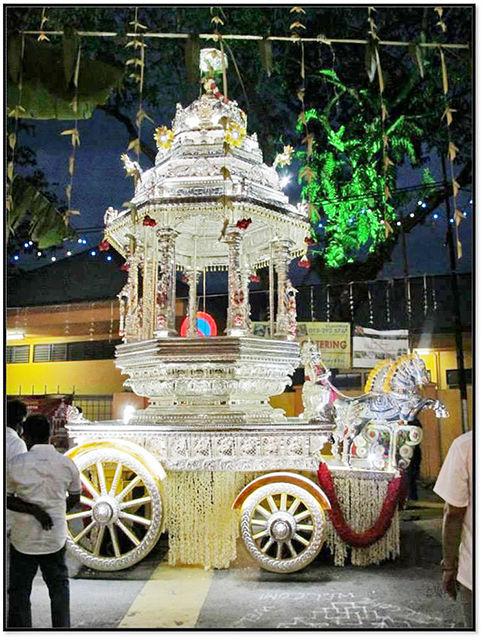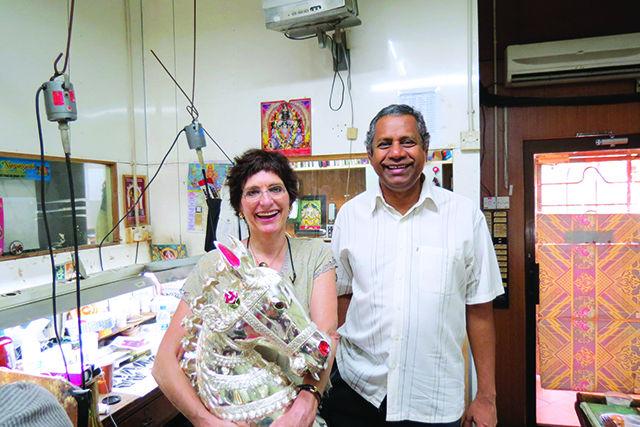Sydney Scherr, a master metalsmith and lecturer at Raffles College of Higher Education in Kuala Lumpur, is the first woman to participate in building a Hindu temple chariot during the course of two years in Malaysia.
Adorned with jewels and immensely detailed metal work completed by hand, the temple on wheels measures to 22 feet tall and consists of 1,760 pounds of burnished sterling silver. It is the only silver chariot in the world to have enameled jewels, which Scherr created and contributed 102 of them the chariot.
Scherr retold this journey of honor, devotion and hard work of all the chariot makers in a presentation at the McKimmon Center on June 24. The participation of Scherr as a fellow chariot maker all began with a man named Mohan Subramaniam.
Scherr recounts their meeting in a tool shop in Malaysia about the time she was trying to uplift the first and only jewelry design program in the country on a university level. Mohan had offered to teach her to use a foot bellows torch filled with jet fuel and spoke of a small jewelry shop that he owned.
“Mohan’s impact on my life and the lives of those around him cannot be understated — his attentive friendship, his appreciation for a well-timed quip, his recognition that his life works well because he believes in the talents of those around him,” Scherr said. “He is one of the most honorable men I have ever known.”
The temple president had commissioned Mohan and his team of jewelers and chariot makers to create this chariot for Ganesha, the Hindu deity of wisdom and remover of obstacles.
“I asked if I could document this process so that the making of a chariot could be seen by those also unfamiliar with this world, and suddenly I was writing a book,” Scherr said.
During the deconstruction of the older chariot, Mohan asked Scherr for her opinion of some sunflower embellishments that encircled the crown. Scherr did not believe they were appealing, and Mohan agreed. He asked that she redesign them for the chariot. It was in this moment that she became a chariot maker and would go on to contribute her unique enamel pieces that only this chariot contains.
“This is such a massive project that the details that you see have gone through extraordinary problem solving to make all these pieces work together,” Scherr said.
The team worked in cramped spaces and utilized tools passed down from their fathers and grandfathers to hammer out the intricate designs by hand and form the metals. Scherr described a palpable feeling of devotion and determination among them as they worked.
“They worked tirelessly and they worked seamlessly, for it was truly a team and it was enlightening to see,” Scherr said. “In my world, teamwork is a fiction, an undesirable. We worry about who gets the credit. The arts can be cutthroat, and no one is eager to share this limelight.”
These chariots are “temples on wheels” and are significant to the community, for they offer everyone a chance to participate in the celebration — especially those who can’t make it to the temple.
“I see that washing over their expressions on the street with this chariot rolling by, this huge temple on wheels,” Scherr said. “People were touching it as if touching something divine, and it meant that to them and I saw it in their faces. I saw pain, I saw joy, I saw wonder, I saw belief — it was spectacular looking at the faces and the hands.”
During this whole journey, Mohan remained aware of all the happenings and needs of the chariot and served as a leader for the team.
“He was so intimately involved in all the big decisions and even the small decisions,” Scherr said. “Even the night we were rolling, the first inaugural night, he was out there making subtle adjustments still, and he’s very, very aware of everything that goes on.”
According to Scherr, as a female in the long journey to build the chariot for Ganesha, she recognized some boundaries and respected these religious differences.
“At this point, the chariot is now done, and it has been consecrated by the priest; I’m not allowed on it anymore,” Scherr said. “I respect that. It’s not my area, it’s not my belief but I respect their belief so I would honor that. When we understand and celebrate what is different about people, we are all elevated.”
As for future chariot work, Scherr says there is a chariot commission in the books for Mohan, and this commission is being negotiated.
“I would love to still be a part of it because it just meant so much to me to be working with these guys,” Scherr said.
With the completion of the chariot project, Scherr and the other chariot makers have learned from one another, and a rolling temple has been born out of this collaboration filled with hard work, tenacity and devotion that lives on through every hammered, soldered, shaped and polished detail in the chariot.









